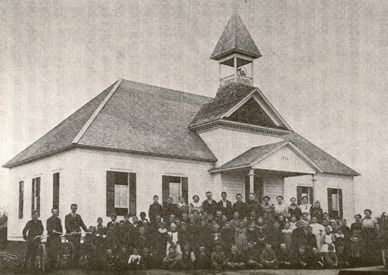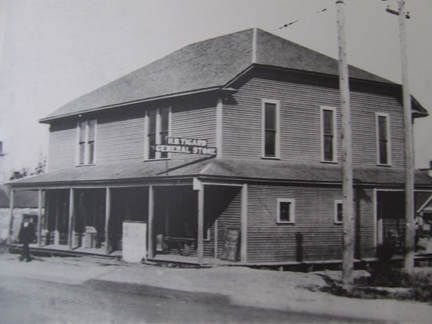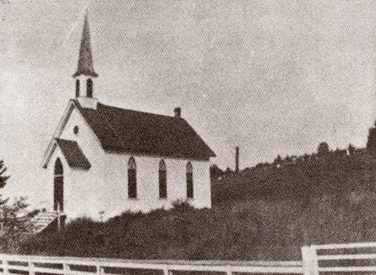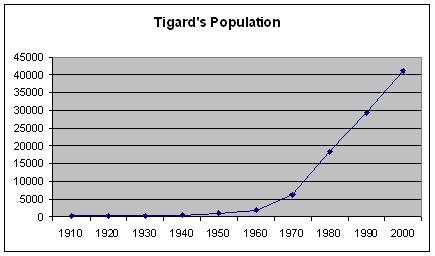A Short History of Tigard, Oregon
Early Inhabitants
|
||
The Washington County Historical Society had a good article covering some
of the early Native American inhabitants of the Tigard area. At this time
I am not certain if that article is still available on their website.
|
||
First Settlers
|
||
The first recorded settlers in the Tigard area were probably those who
are documented by their Donation Land Claims (defined in Wikipedia).
Among the early settlers around the current downtown area are:
At least one earlier settler is mentioned in a biography of Wilson Tigard published in a volume titled "History of Oregon" (1893) which states "Like many of the other emigrants he (Wilson Tigard) had no money so paid for his 320 acres of land with two Spanish cows, which he obtained from Mr. George Richardson. The man who owned the claim was a Mr. Matthews and he had built a small log shanty on the land on which Mr. Tigard and his family made their home for the first year." |
||
Wilson Tigard Arrives
|
||
Wilson M. Tigard, for whom the city was named, arrived in the area in 1852,
establishing his land claim near the claims of George and Solomon Richardson. The area
at that time was known as Butte, or East Butte (not to be confused with Butteville
farther south). The origins of these names are unclear.
 East Butte School |
||
First Store and Church
|
||
The pioneer community continued without much further civic organization
until 1880 when Charles F. Tigard, Wilson's son, built the general store
and meeting hall that became the center of the Butte community. Unlike
similar commercial developments in the area, such as the general store
in Tualatin, the Tigard store was not located on a major frontier roadway.
As a consequence, it did not presage substantial future development
at that site. The store and its meeting hall upstairs served several area
fraternal groups, and as a polling place.
 The C.F. Tigard Store In the same year the Evangelical organization in Butte built a new church building, called the Emanuel Evangelical Church, at the foot of Bull Mountain, south of the Tigard store.  Emanuel Evangelical Church |
||
More Settlers
|
||
In the early 1890`s the little community began to grow noticeably. John Gaarde
opened a blacksmith shop across the road from the Tigard store, and
a new East Butte school was built to accommodate more pupils.
The growth in the community was based in large part on the influx
of many German settlers during the 1880's and 90's. Many German families,
individuals from the midwest, and immigrants direct from Europe settled here
due to the rich small farm holds available in the area. The German population
of the community does not seem to have been a factor in its early identity,
unlike the ethnic populations in Helvetia and Verboort.
|
||
Tigardville At the Turn of the Century
|
||
As with other such communities in Washington County, the real pivotal point
in Tigard's history was the arrival of the electric interurban commuter trains
that radiated out of Portland in the first decades of the twentieth century.
It was the anticipation of the arrival of rail service that caused both
a geographic reorientation for Tigardville and a major increase in development.
Between 1907 and 1910, several new commercial building were built along what
was to become Main Street. The focus for the emerging village had moved
northeast approximately one mile to the new rail stop. In 1907 Germainia Hall
was built, a two story frame building featuring a restaurant, grocery store,
a dance hall, and rooms to rent. Two other buildings, a shop and post office
combination, and a livery stable were built all on the east side of the road
between the rail line right-of-way and Burnam Street, although the livery stable
was moved across the road later. In 1908 limited telephone service began in Tigardville.
|
||
The Oregon Electric Railroad Comes to Tigardville
|
||
In 1910, the
Oregon Electric Railroad began its daily service to Tigardville,
and almost immediately the railroad shortened the name on its station to Tigard,
in order to avoid confusion with Wilsonville, located to the south. As the village
was not an incorporated city the change was by fiat of the Oregon Electric RR, and
it held. There is no record of any effort to oppose the change, so it appears
that it was not an issue to the locals. In 1911 the Tualatin Valley Electric company
electrified the Tigard community, joining it to a service grid that included Sherwood
and Tualatin. In 1912 William Ariss built a blacksmith shop on Main Street,
a business that evolved over the years into a modern service station.
The new Tigard was taking on the look of a typical small town, with dirt streets, board walks, and wood frame, false-fronted shops. (Main Street was not paved or provided with concrete walks until the late '30s). In the same year, St. Anthony's Catholic church built a new brick school to accommodate its growing student body. The parish had organized itself a few years earlier, and had recruited vigorously amongst the large German community, to the extent that German-language services were a feature of the parish. |
||
Into the 20`s
|
||
Tigard's population in 1915 was approximately 300. The Southern Pacific's
"Red Electric" had by then joined the Oregon Electric in providing commuter rail
service to Tigard, on a parallel right-of-way. A period account characterized
Tigard as a rail stop surrounded by fruit, walnuts and truck gardens.
Over the next dozen years Tigard expanded its business community.
In 1916 the Tigard Lumber Co. was initiated by the Johnson family,
a major business on Main Street based on the new rail line. The company's
success was based in large part on new homes built in the Tigard area.
Another new business was a mattress factory in 1923. In the same year,
Tigard got its first newspaper, the Tigard Sentinel.
 Banner of the First Issue of the Tigard Sentinel |
||
A New Highway and New Businesses
|
||
Perhaps more important to Tigard`s history, Tigard was transected by the new
2-lane Capitol Highway. The auto had come of age, and Tigard's commercial
district was by-passed by the new highway. The Lone Oak Service station was
the first highway-related business built on the route. In 1925, Tigard acquired
its first bank, organized by prominent locals, a bank which never closed its doors
during the Depression. Other new businesses opened on Main Street, a Union High School
district was formed, and a commercial club was organized. It was this organization
that seemed to contain the seeds of civic leadership, as a volunteer fire department
was a high priority on its agenda. In 1927 a major development for Tigard occurred
when the Johnson building, a 2-story structure housing a drug store, coffee shop and
post office was built north of the rail line. Johnson drained a swampy area, and
built not only this building but an auto dealership and a garage. Prior to this time,
the north side of the tracks was simply residential.
|
||
The 30`s and 40`s
|
||
By the early thirties the population had not grown much beyond the 300 of 1915
(328 in 1928). The growth of the twenties slackened, and a major fire in August of 1931 on Main
prompted a prominent businessman, Mr. Schubering, (whose store the fire damaged)
to advocate incorporation and real fire protection. Tigard was still relying
on the Portland Fire Department at this time. One of the more interesting aspects
of the Depression years was the presence of a "Hooverville" on the rail line
near the Huntziker farm outside Tigard. This encampment remained throughout the war
and after.
|
||
Tigard After World War II
|
||
The pressures toward and interest in incorporation apparently became irresistible,
even for stolid Tigard, and at the surprisingly late date of 1961, Tigard legally became a city.
In the early 1960`s, Tigard`s population was about 2,000. By 1970 the population had tripled to 6,300. By 1980 the population tripled again to over 18,000. Rapid growth continued with an additional 10,000 people moving to Tigard in each of the next two decades. |
||
Adapted from the Washington County Cultural Resource Report
